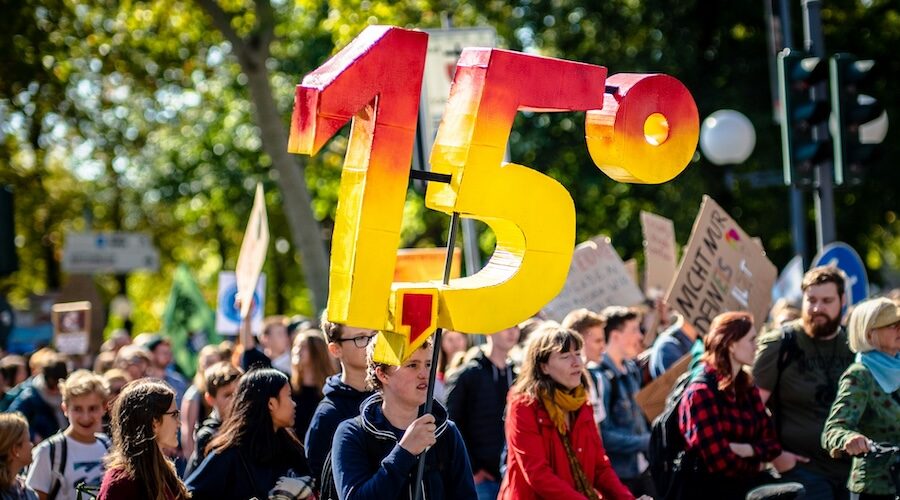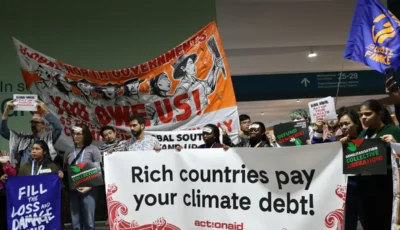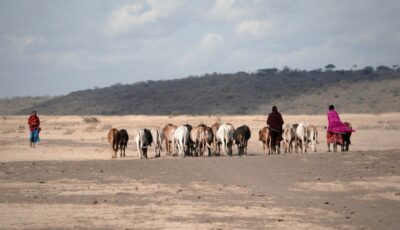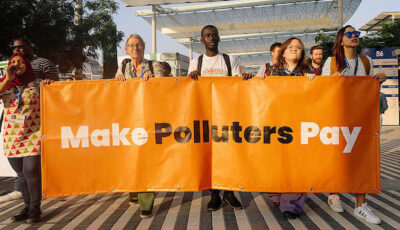The Paris Agreement’s promise of a unified climate solution faces a harsh reality of injustices and inadequate action. As ever, the spotlight must fall squarely on the provision of climate finance from developed to developing countries, writes Meenakshi Raman for the Third World Network.
When the Paris Agreement was announced 10 years ago in 2015, the world was euphoric, as it was the culmination of many years of protracted negotiations under the United Nations Framework Convention on Climate Change (UNFCCC). Following the collapse of the Copenhagen climate talks in 2009, the multilateral climate regime was viewed as having endured and ultimately prevailed. It took five intense years of negotiations to deliver the Paris Agreement at the 21st Conference of the Parties to the UNFCCC (COP21), which was no mean feat.
In the run-up to the accord, the North-South divide remained pronounced across numerous issues, particularly regarding the recognition of equity and the principle of common but differentiated responsibilities and respective capabilities. Tensions centred on how to reflect differentiated obligations between developed and developing countries. In the end, the Paris Agreement’s provisions reflected a fragile and delicate outcome, which set out clearly the obligations of developed and developing countries, with differentiation clear in many provisions but somewhat blurred in some aspects, for instance, in the reporting arrangements under the enhanced transparency framework.
While many viewed the Paris Agreement as falling short of what was needed to save the planet and protect the poor, others argued that, given the prevailing political constraints, particularly a hostile United States Congress during Barack Obama’s presidency, it represented the best possible outcome at the time and laid a foundation for greater ambition in the future.
The global stocktake (GST) under Article 14 of the Paris Agreement was viewed by many, especially the European Union, as the ambition rachet mechanism, where after a collective assessment of progress toward achieving the purpose of the Paris Agreement and its long-term goals, the outcome of the GST, as noted in its proposal, “shall inform Parties, in updating and enhancing, in a nationally determined manner, their actions and support, … as well as in enhancing international cooperation for climate action.”
The first GST took place in 2023 in Dubai at COP28, and the parties were required to submit their new nationally determined contributions (NDCs) by COP30 in 2025 in Belem, Brazil. These NDCs will cover the time frame of 2031 to 2035, since the first NDCs covered the time frame of 2021–2030. According to the Paris Agreement architecture, the GST will be conducted every five years, and the next is due in 2028.
Also in controversy in Paris was the scope of the NDCs, with developed countries pushing the narrative that it should only comprise mitigation targets, while the Like-Minded Developing Countries (LMDC) advanced the position that NDCs are not only about mitigation. The LMDC’s view eventually prevailed, with Article 3 of the Paris Agreement reflecting that NDCs are “a global response to climate change” and parties are to undertake and communicate “ambitious efforts”, which can include mitigation, adaptation and the means of implementation that are needed or to be provided.
A synthesis report of the latest NDCs is expected ahead of COP30 to be held in Belem, Brazil, and it will likely confirm what many already fear: governments remain far off track in limiting global temperature rise to 1.5°C — or even 2°C — above pre-industrial levels.
The report is expected to trigger renewed calls for greater ambition to close the emissions gap. This urgency is underscored by alarming findings from the World Meteorological Organisation, which reports that the past decade has been the warmest on record, and that there is a 70% probability that the five-year average temperature between 2025 and 2029 will exceed 1.5°C. These projections are not abstract — they signal a rapidly narrowing window to prevent irreversible climate damage and demand bold, immediate action.
Fair share of justice
The elephant in the room remains: who will bridge the global emissions gap?
Is it just to expect developing countries to shoulder greater responsibility when developed nations – historically the largest emitters — have yet to deliver their fair share of reductions? Despite their disproportionate use of the planet’s atmospheric space and longstanding promises to lead on climate action, many have fallen short. The burden of closing the gap cannot be shifted onto those who contributed least to the crisis and who now face the steepest challenges in adapting to the consequences.
In the GST decision from Dubai in 2023, these concerns were noted, remarking “that the carbon budget consistent with achieving the Paris Agreement temperature goal is now small and being rapidly depleted and acknowledges that historical cumulative net carbon dioxide emissions already account for about four fifths of the total carbon budget for a 50% probability of limiting global warming to 1.5°C”.
The amount of carbon budget remaining for limiting temperature rise to 1.5°C (with a 50% probability) is 500 gigatonnes (Gt). According to a fair-share assessment by the Indian-based Climate Equity Monitor, for limiting the temperature rise to 1.5°C, the fair share of the remaining carbon budget for developed countries is 87 Gt carbon dioxide equivalent (CO2-eq), if past emissions are not considered. If the total carbon budget is considered, then developed countries have to undertake negative emissions immediately. However, the analysis of current NDCs shows that cumulatively, by 2030, existing developed countries will emit 140 Gt CO2-eq, exceeding their fair share of even the remaining carbon budget by 53 Gt CO2-eq. The Climate Equity Monitor’s analysis also reveals that the developed countries’ current climate mitigation efforts are insufficient for limiting the temperature rise to 1.5°C and overconsume the remaining carbon budget. This is made worse by factoring in the exit in 2025 of the United States from the Paris Agreement.
In the run-up to the adoption of the Paris Agreement, there were proposals from some developing countries (viz., India, Bolivia and Ethiopia) on the need for equitable access to atmospheric space in determining how the remaining carbon budget within a certain temperature rise threshold is to be shared on a per capita basis, taking into account historical responsibility. Such equity-based proposals did not see the light of day due to tremendous resistance from developed countries, especially from the United States, on the grounds that no international agreement can dictate a top-down approach to emissions cuts.
In Paris in 2015, the only consensus possible was through the acceptance of a bottom-up approach, which paved the way for NDCs, under which each country would pledge what it can do voluntarily without any methodology to assess if such reductions are consistent with equity or fairness. In fact, analysis by serious academics and progressive civil society groups have pointed out that rich countries are not doing enough at all and are very far away from what is needed to limit temperature rise.
Instead of focusing on what emission reductions ought to be from a fair-share perspective in order to keep within the remaining carbon budget in an equitable way, at COP 26 in 2021, the United Kingdom presidency pushed the net-zero mantra for all countries, which allows developed countries to get away with targets that amount to doing too little too late and passes on the responsibility to developing countries to do the heavy lifting, without commensurate finance and technology transfer. The Paris Agreement provides for a global aspiration of balancing emissions and sinks by mid-century, and not a country-by-country net-zero target.
Such net-zero announcements have drawn much flak from some developing countries and climate justice groups for being unambitious, not going far and even dubious in the case of some. These groups have called for “real zero” and not “net zero”, starting first with developed countries, which must also be responsible for the provision of financial support for developing countries to head in that direction.
Many of these net-zero pledges are not grounded in deep decarbonisation and rely heavily on “nature-based solutions” as sinks to sequester carbon emissions. Many rely on carbon markets to deliver carbon offsets, mainly in developing countries. What offsetting means is not a reduction of emissions domestically but paying developing countries to reduce emissions in their countries, as it is seen as being more “cost-effective”, and buying the carbon credits to offset the emissions generated in the developed world.
With or without carbon offsetting, such pledges create a huge demand for sinks mainly located in the forests, wetlands and grasslands in developing countries. What seems clear is that the quantity of the sinks needed would exceed the sequestration capacity of the planet by several-fold. This will have negative implications for developing countries, including for conflicts over land use, local communities and Indigenous peoples whose lands and forests are being sought to solve the emissions problem of rich nations. Climate justice groups have referred to this as “carbon colonialism”.
Beyond rhetoric to real action
In light of the United States’s withdrawal from the Paris Agreement and the Trump administration’s overt denial of climate change — coupled with the United States’ aggressive promotion of fossil fuels, including pressuring both developed and developing countries through trade deals to increase fossil-based energy consumption — the global trajectory has veered dangerously toward climate catastrophe.
Like a schoolyard bully whose actions threaten the collective well-being, such behaviour demands a unified and forceful response from the international community. Yet, at the Bonn climate talks in June this year, the broader developed world failed to demonstrate meaningful commitment to renewed cooperation with developing countries.
Instead, they continued to dilute their responsibilities and evade their obligations, particularly in the critical area of climate finance — undermining trust and jeopardising the prospects for equitable global climate action.
The assertion that wealthy nations lack adequate financial resources is untenable — particularly when substantial funds are readily mobilised to support arms sales to Israel amid its devastating genocide in Gaza and to expand military defences and security infrastructure globally. This stark contrast exposes a troubling prioritisation of geopolitical interests over planetary survival.
Meanwhile, climate impacts continue to escalate, with extreme events, such as heatwaves, droughts, wildfires and floods, disproportionately affecting vulnerable populations. In this context, developing countries must urgently focus on adaptation and on addressing loss and damage.
This is precisely why COP30 must centre the priorities of the Global South. The spotlight must fall squarely on the provision of climate finance from developed to developing countries — a binding obligation under the Paris Agreement. It must also advance meaningful support for just transitions, scale up adaptation efforts and deliver concrete funds to address loss and damage. Anything less would be a betrayal of climate justice.
It is no longer sufficient to merely invoke the need to save multilateralism. What is at stake is far greater — we must deliver on saving the planet and protecting the world’s most vulnerable. This demands genuine, transformative solutions rooted in international cooperation, not the tired cycle of blame-shifting and rhetorical sleight of hand.
The time for smokescreens and symbolic gestures has passed; what is needed now is bold, accountable action that prioritises justice, equity and survival.
This article first appeared in ‘Focus 23: Global South’s Climate Agenda’ by the Institute of Strategic and International Studies (ISIS) Malaysia.
Original source: Third World Network
Image credit: Mika Baumeister, Unsplash





